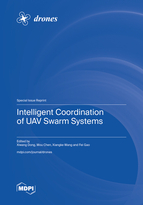Intelligent Coordination of UAV Swarm Systems
A special issue of Drones (ISSN 2504-446X). This special issue belongs to the section "Drone Communications".
Deadline for manuscript submissions: closed (31 March 2023) | Viewed by 69222
Special Issue Editors
Interests: swarm intelligence; collaborative control; collaborative guidance; collaborative decision-making planning; UAV swarm; UAV flight control and embedded system
Interests: control systems engineering; electrical engineering; aerospace engineering
Special Issues, Collections and Topics in MDPI journals
Interests: swarm intelligence; cooperative control; intelligent decision; flight control; UAV swarm systems
Special Issue Information
Dear Colleagues,
Unmanned aerial vehicle (UAV) swarm systems have broad application prospects in many practical fields, such as cooperative surveillance, coordination transportation, communication relay, and so on. UAV swarm systems are promising because the emergent behavior has the features of low cost, high scalability and flexibility, great robustness, and easy maintenance. In order to greatly improve the mission execution efficiency of UAV swarm systems, intelligent coordination theory and technology has become a cutting-edge and difficult research focus in the past several decades. How to design distributed cooperative approaches to realize the organic collaboration of perception and cognition, navigation and positioning, decision and planning, guidance and control, and evaluation and verification is a hot topic of current academia and industry.
This Special Issue originates from "2022 5th IEEE International Conference on Unmanned Systems (IEEE ICUS 2022, https://icus2022.c2.org.cn/index.html), which will be held on 14-16 October 2022, Guangzhou, China. The most exciting and innovative papers related to drones presented at IEEE ICUS 2022 will be selected to be extended and included in this Special Issue.
This Special Issue focuses on the latest research results for the intelligent coordination of UAV swarm systems. Papers are solicited in areas directly related to these topics, including, but not limited to, the following:
- UAV swarm intelligent perception and cognition;
- Autonomous navigation and positioning;
- Intelligent decision making and motion planning;
- Cooperative guidance;
- Distributed control;
- Simulation and experiment verification for UAV swarm systems.
Prof. Dr. Xiwang Dong
Prof. Dr. Mou Chen
Prof. Dr. Xiangke Wang
Dr. Fei Gao
Guest Editors
Manuscript Submission Information
Manuscripts should be submitted online at www.mdpi.com by registering and logging in to this website. Once you are registered, click here to go to the submission form. Manuscripts can be submitted until the deadline. All submissions that pass pre-check are peer-reviewed. Accepted papers will be published continuously in the journal (as soon as accepted) and will be listed together on the special issue website. Research articles, review articles as well as short communications are invited. For planned papers, a title and short abstract (about 100 words) can be sent to the Editorial Office for announcement on this website.
Submitted manuscripts should not have been published previously, nor be under consideration for publication elsewhere (except conference proceedings papers). All manuscripts are thoroughly refereed through a single-blind peer-review process. A guide for authors and other relevant information for submission of manuscripts is available on the Instructions for Authors page. Drones is an international peer-reviewed open access monthly journal published by MDPI.
Please visit the Instructions for Authors page before submitting a manuscript. The Article Processing Charge (APC) for publication in this open access journal is 2600 CHF (Swiss Francs). Submitted papers should be well formatted and use good English. Authors may use MDPI's English editing service prior to publication or during author revisions.
Keywords
- UAV swarm systems
- intelligent perception and cognition
- swarm navigation and positioning
- autonomous decision and planning
- cooperative guidance and control
- UAV simulation and experiment
- swarm intelligence









